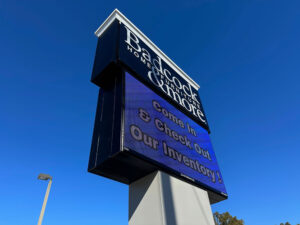
As college campuses continue to expand in size and complexity, navigating through the labyrinthine pathways can feel like embarking on an adventurous quest. However, the ingenious use of campus wayfinding signage has transformed this daunting task into a much more manageable experience. These signs serve as vital navigational aids, guiding students, faculty, and visitors to their intended destinations efficiently. In this article, we will explore the different types of campus wayfinding signage, shed light on their significance, and delve into the interesting facts surrounding these invaluable navigational aids.
Campus wayfinding signs play a crucial role in simplifying the intricate maze of educational institutions. Whether it’s directional signs, building identification signs, pathway markers, parking signs, or information kiosks, each type serves a specific purpose in ensuring clarity and ease of navigation. These signs incorporate accessibility features, maintain consistent branding, and adapt to evolving technology, making them indispensable tools in empowering individuals to navigate campuses with confidence. Join us on this exploration of campus wayfinding signage as we uncover their hidden gems and appreciate their profound impact on enhancing the overall campus experience.
Types of Campus Wayfinding Signage
- Directional Signs: Directional signs serve as the backbone of campus wayfinding systems. Strategically placed at crucial junctions, they provide clear and concise instructions, directing individuals toward specific buildings, facilities, parking lots, and landmarks. These signs often include arrows, maps, and written descriptions to assist users in choosing the correct path.
- Building Identification Signs: To help individuals identify and locate specific buildings, campus wayfinding signage includes building identification signs. These signs are typically placed near the entrances and display the building name, number, and sometimes additional information such as department names or room numbers. Building identification signs contribute to the overall clarity of the campus layout.
- Pathway Markers: For pedestrians traversing the campus on foot, pathway markers are an essential part of the wayfinding system. These signs are placed at regular intervals along walkways and help users maintain their orientation. Pathway markers often display the names of nearby buildings or landmarks, ensuring individuals remain on the correct route and prevent getting lost.
- Parking Signs: One of the most critical aspects of campus wayfinding is efficient parking. Parking signs provide information about designated parking areas, permit requirements, and any restrictions. These signs help drivers locate parking lots, identify available spaces, and understand parking regulations, contributing to a smoother flow of traffic within the campus.
- Information Kiosks: In addition to traditional signage, many campuses employ information kiosks as part of their wayfinding systems. These interactive touchscreen displays provide users with maps, directions, and other relevant information about the campus. Information kiosks are particularly helpful for visitors who are unfamiliar with the campus layout and need immediate guidance.

Campus wayfinding signs are not just ordinary navigational aids; they are rich sources of intriguing facts waiting to be discovered. Beyond their primary purpose, these signs encompass a range of fascinating aspects that contribute to the overall campus experience. From their careful attention to accessibility considerations to their role in maintaining consistent branding, campus wayfinding signs play a significant role in enhancing navigation on campus. Below are some of the lesser-known facts about these navigational signs, shedding light on their immense importance and innovative impact in the realm of campus navigation.
Interesting Facts about Campus Wayfinding Signs
- Accessibility Considerations: Campus wayfinding signs are designed with accessibility in mind. They often incorporate braille, tactile elements, and high contrast colors to accommodate visually impaired individuals. Additionally, signs are typically mounted at appropriate heights to ensure they are easily readable for people of all heights, including those using wheelchairs or mobility aids.
- Consistency and Branding: To maintain a cohesive visual identity, many campuses employ consistent design elements and branding guidelines across their wayfinding signage. This helps create a sense of unity and familiarity, making it easier for users to navigate multiple areas of the campus without confusion.
- Evolving Technology: Advancements in technology have also impacted campus wayfinding. Some institutions have implemented digital signage systems that can be easily updated in real-time. These systems can display dynamic information such as event schedules, weather updates, and emergency alerts, further enhancing the effectiveness of campus wayfinding efforts.
Campus wayfinding signs are indispensable tools that revolutionize navigation within educational institutions. These signs, including directional signs, building identification signs, pathway markers, parking signs, and information kiosks, ensure a seamless journey for students, faculty, and visitors alike. With their accessibility features, consistent branding, and evolving technology, campus wayfinding signs continue to evolve and adapt to meet the needs of diverse users. As we appreciate the fascinating facts surrounding these signs, we recognize their crucial role in simplifying the intricate maze of campuses and empowering individuals to navigate with confidence. So, the next time you embark on your educational journey, take a moment to appreciate the campus wayfinding signage guiding your path and making your experience even more enjoyable and effortless.






